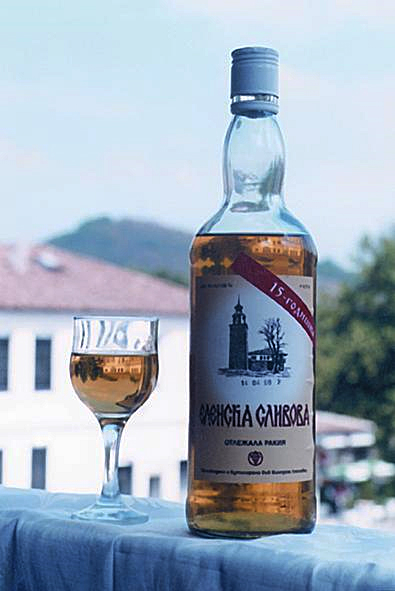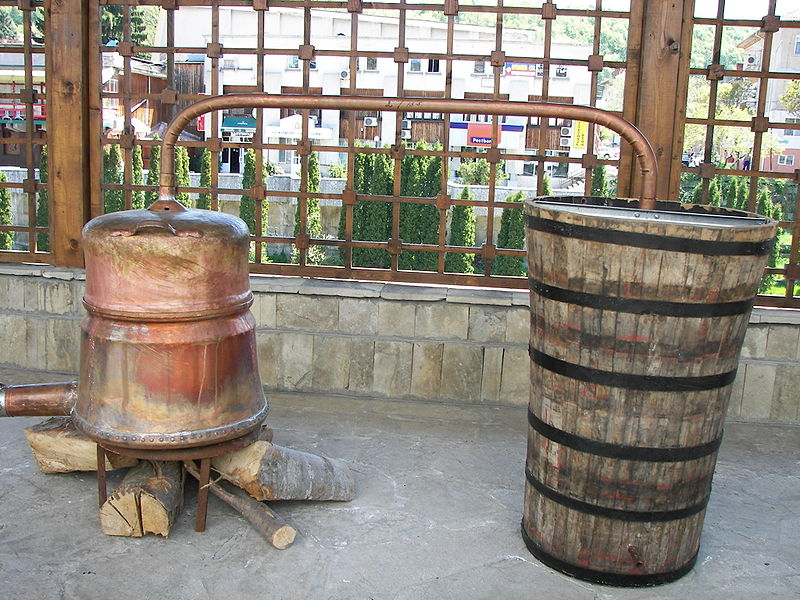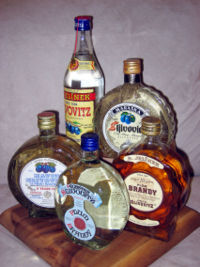In the heart of the former Yugoslavia lies an old tradition still quite unknown to the rest of the world: rakija (pronounced RA KEE YA). Rakija is the Serbo-Croatian name given to an alcoholic drink made from the distillation of fermented fruit. It is a clear-as-water kind of drink, with a percentage of alcohol that can range from approximately 40% to 65%. You might think that rakija is similar to  brandy or schnapps and that there’s nothing new here. But in fact, there lies an entire world to be discovered, as rakija has its own tradition, its own rituals and particularities.
brandy or schnapps and that there’s nothing new here. But in fact, there lies an entire world to be discovered, as rakija has its own tradition, its own rituals and particularities.
Rakija can be made out of almost any fruit, and each fruit has its own specific rakija name. Slivovica (plum rakija) is the most popular, as well as the cheapest and strongest. You can find slivovica in every Slavic country, from the Czech Republic to Bulgaria, and each country claims the drink as its own.
For Serbians, rakija means much more than just slivovica, and if you know the right places, you can find yourself enjoying the pleasures of the most diverse kinds of rakija: apricot, peach, grape, fig, quince and even juniper. Each version has its own subtle and particular taste lying just beneath the initial strong flavor.
Understanding rakija is a process that involves identifying and enjoying the different types of rakija, but also following the tradition of respect that comes with this ritual.
Serbians take much pride in producing rakija in the home. Making your own cheese, jam or wine is nothing strange in Serbia, and making rakija is no exception. Every Serbian either makes their own rakija, has a cousin who makes it, or just knows somebody who makes it.
Try to visit a local festival (you will find rakija producers at any wine festival) or at the Rakija Fest that takes place every September in Belgrade. This is a young festival that is bound to become a big event in a few years.
 If you truly want to get a taste of the real thing, you must know this: get in contact with the locals. They will show you the places where you can get good rakija, or, most likely, will share their own stock with you (commercial rakija is sold in supermarkets, but try to avoid this kind as it contains preservatives.) Serbians are very open and generous people with a big sense of hospitality. They will open the door of their homes to you and treat you as a guest, offering you food and making you feel comfortable as if you are among friends. Even if their knowledge of English is little to none, through their gesticulation and big smiles, you will know you are in a safe place.
If you truly want to get a taste of the real thing, you must know this: get in contact with the locals. They will show you the places where you can get good rakija, or, most likely, will share their own stock with you (commercial rakija is sold in supermarkets, but try to avoid this kind as it contains preservatives.) Serbians are very open and generous people with a big sense of hospitality. They will open the door of their homes to you and treat you as a guest, offering you food and making you feel comfortable as if you are among friends. Even if their knowledge of English is little to none, through their gesticulation and big smiles, you will know you are in a safe place.
Being a guest also means you will immediately be offered some rakija, no matter what time of the day it is. So please try not to reject it even if you don’t feel like drinking. They will expect you to at least try it. If you don’t feel like drinking more, leave some in the bottom of your glass. Be aware that if you finish the entire glass, they are going to keep pouring more. A rakija session can surprise you at anytime of the day, even in the morning, and will quickly put you in a tipsy state. So don’t overdo it, as this drink should be taken with a lot of respect.
When you are among the locals, you will learn all there is to know about the old tradition of rakija, and they will be happy to talk extensively about the subject. Still, here are a few tips to keep in mind: Good rakija has a strong taste first, followed by a subtle fruity flavor. Although rakija is served in shot glasses, you do not need to drink it all in one sip. The first sip is the most important. Before taking this initial taste, exhale deeply, and then take a quick sip directly down your throat right to the stomach. Now take in a long breath through your nose. You should feel the burning in your chest, not in your throat. Try to distinguish the fruity flavor that appears gradually.
 Now you are ready to start experiencing the world of rakija. Your new goal is to try to find the most diverse home-made varieties of rakija. You will have better luck in small towns where people can direct you to the people selling their own rakija than in big cities. Knock on a door, introduce yourself politely, and you could find yourself being drawn down into a cellar by an old man, where you end up trying various rakijas directly from the barrel where they are being aged, and where you can buy bottles at a very cheap price (usually less than 10 euros per liter). Don’t be worried if you receive your rakija in a reused mineral water plastic bottle–that’s as domace (homemade) as it can get!
Now you are ready to start experiencing the world of rakija. Your new goal is to try to find the most diverse home-made varieties of rakija. You will have better luck in small towns where people can direct you to the people selling their own rakija than in big cities. Knock on a door, introduce yourself politely, and you could find yourself being drawn down into a cellar by an old man, where you end up trying various rakijas directly from the barrel where they are being aged, and where you can buy bottles at a very cheap price (usually less than 10 euros per liter). Don’t be worried if you receive your rakija in a reused mineral water plastic bottle–that’s as domace (homemade) as it can get!
And don’t forget to buy your own bottle and take it back home to share with your friends, as you tell them all about the tradition and rituals surrounding rakija. In that bottle lies the spirit of a country full of history and hospitality.
Written by Ezequiel Gomez Davel for EuropeUpClose.com


Comments